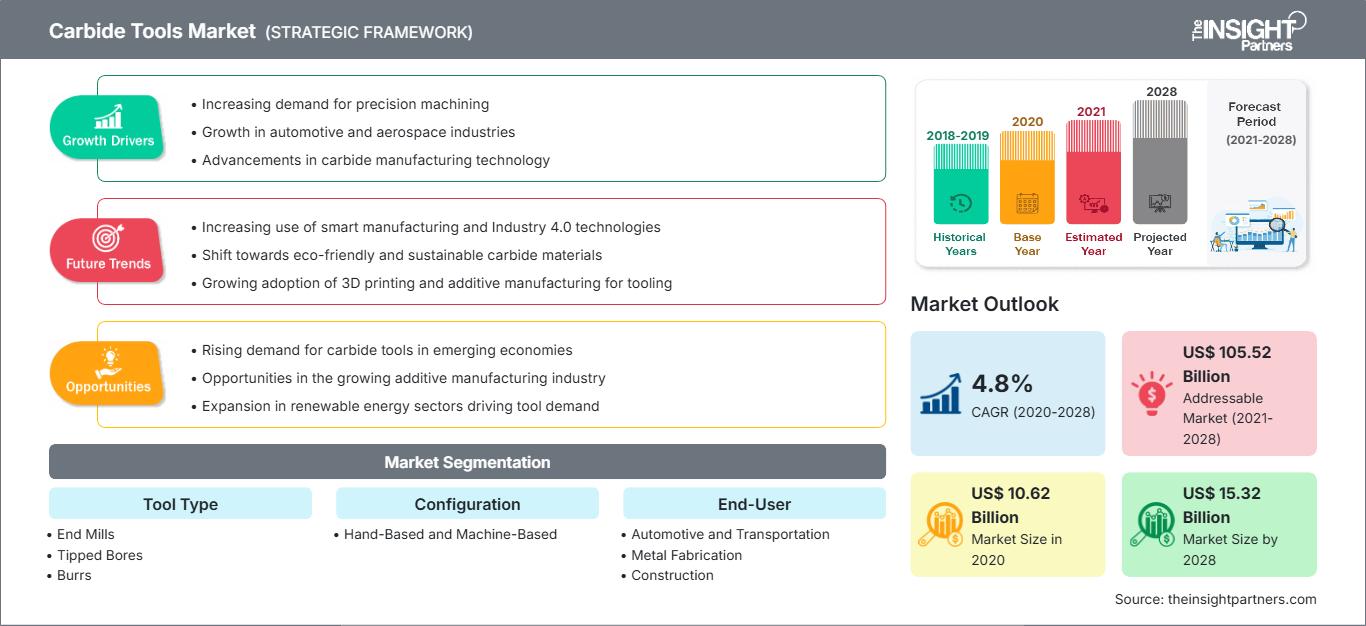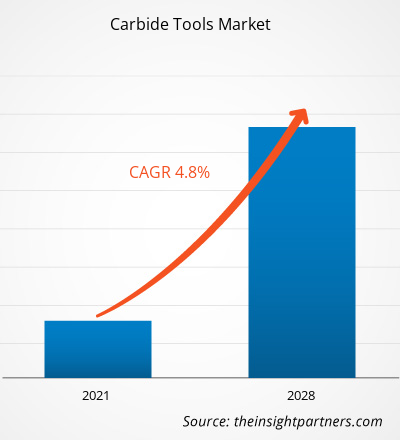[Rapporto di ricerca]Il mercato degli utensili in metallo duro è stato valutato a 10.623,97 milioni di dollari nel 2020 e si prevede che raggiungerà i 15.320,99 milioni di dollari entro il 2028; si prevede una crescita a un CAGR del 4,8% dal 2021 al 2028.
I crescenti sviluppi nella progettazione della produzione e le crescenti esigenze di aumento dell'efficienza produttiva stanno gettando le basi per la ricerca da parte dei produttori di prodotti per macchine utensili di qualità superiore, incrementando così la domanda di utensili in metallo duro. Le macchine utensili utilizzate in tutti i settori sono principalmente impiegate per la lavorazione o la sagomatura di metalli o altri materiali rigidi per offrire una forma unica mediante alesatura, rettifica, cesoiatura e taglio. Attualmente, esistono due tipi principali di macchine utensili utilizzate in modo significativo in diversi settori: acciaio rapido (HSS) e utensili in metallo duro. Questi utensili sono ampiamente utilizzati in diverse applicazioni di lavorazione meccanica grazie alle loro caratteristiche significative, come l'alta velocità, i tempi di ciclo ridotti, la lunga durata, il mantenimento del tagliente ad alte temperature di lavorazione e l'eccezionale resistenza all'usura del tagliente. La crescente popolarità degli utensili in metallo duro, in particolare nelle applicazioni manifatturiere, è uno dei fattori significativi che si prevede stimolerà il mercato durante il periodo di previsione. Inoltre, questi utensili in metallo duro vengono utilizzati in unità produttive nei settori automobilistico, aerospaziale, ferroviario, dell'arredamento e della carpenteria, dell'energia e delle apparecchiature sanitarie. In questi settori, vengono utilizzati utensili da taglio speciali per progettare e realizzare un prodotto, il che sta incrementando la domanda di utensili in metallo duro. L'impiego di utensili in metallo duro in diversi settori, per l'azionamento manuale o automatico, sta ulteriormente stimolando la crescita del mercato degli utensili in metallo duro a livello globale.
Personalizza questo rapporto in base alle tue esigenze
Potrai personalizzare gratuitamente qualsiasi rapporto, comprese parti di questo rapporto, o analisi a livello di paese, pacchetto dati Excel, oltre a usufruire di grandi offerte e sconti per start-up e università
Mercato degli utensili in metallo duro: Approfondimenti strategici

- Ottieni le principali tendenze chiave del mercato di questo rapporto.Questo campione GRATUITO includerà l'analisi dei dati, che vanno dalle tendenze di mercato alle stime e alle previsioni.
Impatto della pandemia di COVID-19 sul mercato degli utensili in metallo duro
Potrai personalizzare gratuitamente qualsiasi rapporto, comprese parti di questo rapporto, o analisi a livello di paese, pacchetto dati Excel, oltre a usufruire di grandi offerte e sconti per start-up e università
Mercato degli utensili in metallo duro: Approfondimenti strategici

- Ottieni le principali tendenze chiave del mercato di questo rapporto.Questo campione GRATUITO includerà l'analisi dei dati, che vanno dalle tendenze di mercato alle stime e alle previsioni.
La pandemia di COVID-19 ha scosso diversi settori. L'enorme crescita della diffusione del virus ha spinto i governi di tutto il mondo a imporre severe restrizioni alla circolazione di veicoli e persone. A causa di divieti di viaggio, lockdown di massa e chiusure aziendali, la pandemia ha avuto un impatto negativo sulle economie e su innumerevoli settori in diversi paesi. L'imposizione del lockdown ha comportato una minore produzione di materie prime, beni e servizi. Pertanto, i settori manifatturiero, automobilistico, dei semiconduttori e dell'elettronica, petrolifero e del gas, minerario, aeronautico e altri hanno assistito a un calo delle loro attività a causa della temporanea chiusura delle attività.
Il lockdown mondiale per ridurre al minimo la trasmissione del virus ha interrotto significativamente le attività della catena di approvvigionamento e i volumi di produzione di diversi produttori, in particolare delle piccole e medie imprese. Inoltre, le attività produttive in diversi settori si sono contratte significativamente nel corso del 2020, con conseguente calo del mercato degli utensili in metallo duro. Tuttavia, con la crescente domanda di prodotti sanitari, la domanda di utensili in metallo duro sta aumentando vertiginosamente nel settore medico.
Approfondimenti sul mercato degli utensili in metallo duro: l'aumento della produzione nel settore automobilistico alimenta la crescita del mercato degli utensili in metallo duro
La produzione automobilistica è in costante crescita in tutto il mondo, in particolare nei paesi asiatici ed europei, il che sta alimentando la domanda di utensili in metallo duro. Il settore utilizza ampiamente utensili in metallo duro nella lavorazione dei metalli degli alberi motore, nella fresatura frontale e nella foratura, tra le altre lavorazioni meccaniche coinvolte nella produzione di componenti per auto. L'industria automobilistica sta ottenendo ottimi risultati con l'uso del carburo di tungsteno in giunti sferici, freni, alberi motore di veicoli ad alte prestazioni e altre parti meccaniche di veicoli sottoposti a un uso intenso e a temperature estreme. Giganti dell'automotive come Audi, BMW, Ford Motor Company e Range Rover stanno contribuendo in modo significativo alla crescita del mercato degli utensili in metallo duro. I veicoli elettrici ibridi stanno guadagnando terreno in Nord America, stimolando così la crescita del mercato degli utensili in metallo duro nella regione. Paesi come gli Stati Uniti e il Canada sono importanti produttori automobilistici nella regione. Secondo l'American Automotive Policy Council, le case automobilistiche e i loro fornitori contribuiscono per circa il 3% al PIL degli Stati Uniti. General Motors Company, Ford Motor Company, Fiat Chrysler Automobiles e Daimler sono tra i principali produttori automobilistici del Nord America. Secondo i dati dell'Organizzazione Internazionale dei Costruttori di Veicoli a Motore, nel 2019, Stati Uniti e Canada hanno prodotto rispettivamente circa 2.512.780 e circa 461.370 automobili. Inoltre, gli utensili in metallo duro sono ampiamente utilizzati anche nei settori ferroviario, aerospaziale e della difesa e marittimo.
Approfondimenti di mercato basati sulla tipologia di utensile
In base alla tipologia di utensile, il mercato degli utensili in metallo duro è segmentato in frese a candela, alesatori con punta, frese a disco, punte, frese e altri utensili. Nel 2020, il segmento delle frese ha rappresentato la quota maggiore del mercato.
Approfondimenti di mercato basati sulla configurazione
In base alla configurazione, il mercato degli utensili in metallo duro si divide in utensili manuali e utensili meccanici. Nel 2020, il segmento degli utensili meccanici ha rappresentato una quota di mercato maggiore.
Approfondimenti di mercato basati sull'utente finale
In base all'utente finale, il mercato degli utensili in metallo duro è segmentato in automotive e trasporti, lavorazione dei metalli, edilizia, petrolio e gas, macchinari pesanti e altri utenti finali. Nel 2020, il segmento automotive e trasporti ha rappresentato la quota maggiore del mercato.
Gli operatori che operano nel mercato degli utensili in metallo duro adottano strategie come fusioni, acquisizioni e iniziative di mercato per mantenere le proprie posizioni sul mercato. Di seguito sono elencati alcuni sviluppi dei principali attori:
- A novembre 2020, GARR TOOL ha stretto una partnership con Mastercam per offrire ai clienti una libreria completa di utensili, integrata nella piattaforma Mastercam. La partnership avrà un valore enorme per i clienti attuali e futuri, poiché il processo di produzione dipende sempre più dall'accesso immediato e semplice ai dati.
- A febbraio 2019, il Gruppo CERATIZIT ha acquisito il 50% delle azioni di Stadler Metalle GmbH & Co. KG. L'azienda ha dichiarato che l'investimento in Stadler ha consentito di garantire l'intera catena di fornitura delle materie prime e di concentrarsi ancora di più sul riciclo degli utensili in metallo duro nella fornitura di materie prime.
Mercato degli utensili in metallo duro
Le tendenze regionali e i fattori che influenzano il mercato degli utensili in metallo duro durante il periodo di previsione sono stati ampiamente spiegati dagli analisti di The Insight Partners. Questa sezione illustra anche i segmenti e la geografia del mercato degli utensili in metallo duro in Nord America, Europa, Asia-Pacifico, Medio Oriente e Africa, America Meridionale e Centrale.
Ambito del rapporto di mercato degli utensili in metallo duro
| Attributo del rapporto | Dettagli |
|---|---|
| Dimensioni del mercato in 2020 | US$ 10.62 Billion |
| Dimensioni del mercato per 2028 | US$ 15.32 Billion |
| CAGR globale (2020 - 2028) | 4.8% |
| Dati storici | 2018-2019 |
| Periodo di previsione | 2021-2028 |
| Segmenti coperti |
By Tipo di utensile
|
| Regioni e paesi coperti | Nord America
|
| Leader di mercato e profili aziendali chiave |
|
Densità degli operatori del mercato degli utensili in metallo duro: comprendere il suo impatto sulle dinamiche aziendali
Il mercato degli utensili in metallo duro è in rapida crescita, trainato dalla crescente domanda degli utenti finali, dovuta a fattori quali l'evoluzione delle preferenze dei consumatori, i progressi tecnologici e una maggiore consapevolezza dei vantaggi del prodotto. Con l'aumento della domanda, le aziende stanno ampliando la propria offerta, innovando per soddisfare le esigenze dei consumatori e sfruttando le tendenze emergenti, alimentando ulteriormente la crescita del mercato.

- Ottieni il Mercato degli utensili in metallo duro Panoramica dei principali attori chiave
- Frese
- Fori con punta
- Base
- Trapani
- Frese
- Altri utensili
Per configurazione
- Manuali
- Macchine
Per utente finale
- Automotive e trasporti
- Fabbricazione di metalli
- Edilizia
- Petrolio e gas
- Macchinari pesanti
- Altri utenti finali
Per area geografica
- Nord America
- Stati Uniti
- Canada
- Messico
- Europa
- Francia
- Germania
- Italia
- Regno Unito
- Russia
- Resto d'Europa
- Asia Pacifico (APAC)
- Cina
- India
- Sud Corea
- Giappone
- Australia
- Resto dell'APAC
- Medio Oriente e Asia Africa (MEA)
- Sudafrica
- Arabia Saudita
- Emirati Arabi Uniti
- Resto del MEA
- Sud America (SAM)
- Brasile
- Argentina
- Resto del SAM
Profili aziendali
- Xinrui Industry Co., Ltd.
- CERATIZIT SA
- GARR TOOL
- Ingersoll Cutting Tool Company
- KYOCERA Precision Tools
- DIMAR GROUP
- MITSUBISHI MATERIALS Corporation
- Sandvik Coromant
- YG-1 Co., Ltd.
- Makita Corporation
- Analisi storica (2 anni), anno base, previsione (7 anni) con CAGR
- Analisi PEST e SWOT
- Valore/volume delle dimensioni del mercato - Globale, Regionale, Nazionale
- Industria e panorama competitivo
- Set di dati Excel
Report recenti
Testimonianze
Motivo dell'acquisto
- Processo decisionale informato
- Comprensione delle dinamiche di mercato
- Analisi competitiva
- Analisi dei clienti
- Previsioni di mercato
- Mitigazione del rischio
- Pianificazione strategica
- Giustificazione degli investimenti
- Identificazione dei mercati emergenti
- Miglioramento delle strategie di marketing
- Aumento dell'efficienza operativa
- Allineamento alle tendenze normative




















 Ottieni un campione gratuito per - Mercato degli utensili in metallo duro
Ottieni un campione gratuito per - Mercato degli utensili in metallo duro